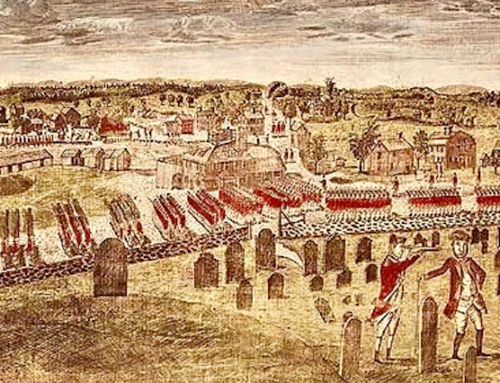Forrest McDonald’s biography of Alexander Hamilton most likely will prove indispensable. What Hamilton thought, and how he came to think it, is nowhere else so plain as here.
Alexander Hamilton: A Biography by Forrest McDonald (464 pages, W.W. Norton & Co., 1982)
 That Alexander Hamilton was among the most luminous and creative of the Founding Fathers every schoolboy has at least an inkling. That he was the only Founding Father who really mattered—the only one who knew what was really good for America—is a notion that will strike many schoolboys, past and present, as a bit peculiar. Yet such is the implicit thesis of Dr. Forrest McDonald’s book, which is an admirable book in a dozen different ways. If only intellectual detachment were one of them!
That Alexander Hamilton was among the most luminous and creative of the Founding Fathers every schoolboy has at least an inkling. That he was the only Founding Father who really mattered—the only one who knew what was really good for America—is a notion that will strike many schoolboys, past and present, as a bit peculiar. Yet such is the implicit thesis of Dr. Forrest McDonald’s book, which is an admirable book in a dozen different ways. If only intellectual detachment were one of them!
The case for lionizing Hamilton—a job McDonald relishes thoroughly—is, on any showing, impressive. The greatness of the man cannot readily or honestly be mistaken, even if, as McDonald notes, the first Treasury Secretary, like the other Founding Fathers, “has had his ups and downs at the hands of historians.”
He was brilliant: That much goes almost without saying. At age twenty-two, he worked out the design of a national bank, whose purpose was the creation of much needed capital. He comprehended any subject on which he turned his ferocious powers of concentration. Yet the brilliant are not by any means rarities. Hamilton’s brilliance made an impact on his times because of his determination and clarity of vision.
In an era of sublime confusion regarding the Republic’s purposes, if any, one can do worse than hark back to Hamilton, who had a crystal-clear vision of the kind of nation he wished the United States to become. McDonald writes:
His vision was grander [than that of the other Founding Fathers]: he sought to transform the American people into free, opulent, and law-abiding citizens, through the instrumentality of a limited republican government, on the basis of consent, and in the face of powerful vested interests in the status quo. The others were content merely to effect a political revolution. He set out to effect what amounted to a social revolution.
The revolution would proceed in accordance with Hamilton’s own values. His notion was that money should become the agent of transformation—in McDonald’s words, “the universal measure of the value of things.” So consecrated, money would make society “fluid and open to merit;” industry would become “both rewarding and necessary.” And America’s greatness would be guaranteed.
An audacious, even a presumptuous, design. Hamilton was, at all events, in no doubt as to what should be done. As McDonald points out, “his true genius…was for running things, for organizing and regularizing human activity and establishing procedures whereby work could most effectively be done.”
The Hamilton known to schoolboys is something of a haughty aristocrat. And in fact his social design called for the best men to run the country. Yet these would be men raised up by their own merits, not by birth or preferment. McDonald tells us that Hamilton hated “the American system of pluralistic local oligarchies [that] made everyone dependent upon those born to the oligarchy. He hated the narrow provincialism that the system nourished and fed upon.” Not least did he resent the system’s failure to reward hard work.
What was wanted, then, was “efficient fiscal machinery,” beneficial to all; so crucial to life and to government that “it would be almost impossible to dismantle the machinery short of dismantling the whole society.”
Accordingly, as Secretary of the Treasury, Hamilton worked to have the federal government assume the debts of the states. The public debt, as a whole, would not be paid off quickly; rather, payments would be stretched out over time in order to expand the supply of money. Mere paper would thus become a form of capital. A mint and a national bank were likewise wanted, and in due course Hamilton procured their establishment. No laissez faire economist like his contemporary Adam Smith, Hamilton sought government protection and subsidies for American industry. He believed, to be sure, in what we should nowadays call private enterprise. In McDonald’s words, Hamilton thought that
The function of government should be to promote a general spirit of improvement. It should reward productivity and punish dissipation, idleness, and extravagance. Taxes should be designed to encourage industry, never to impede it. Regulation of productive activity should be confined to inspection to prevent frauds and ensure the highest quality and marketability of products.
It goes without saying that painfully few twentieth-century politicians can have read their Hamilton conscientiously, if at all. Since the 1930s, the first Treasury Secretary has been a prophet largely unhonored by a country whose future was his greatest obsession (along with personal fame, at least). In Hamilton, there plainly is much to admire. McDonald would not have him just admired, though.
The foremost of the Founding Fathers, unique in his mental powers, breadth of vision, and intellectual honesty: Such is the Hamilton whom McDonald installs upon a lofty pedestal, alongside which the other founders look exceedingly paltry. John Adams is “pompous and porcine.” Jefferson, an “intellectual dilettante,” is given to “legalistic pettifoggery” in opposing Hamilton’s designs. Madison is narrow in his views, Washington a stilted backdrop before which Hamilton charts his grand designs. That all the foregoing made important practical and philosophical contributions to the new Union, McDonald’s readers must trouble themselves to discover elsewhere.
To Hamilton’s opponents, McDonald concedes nothing. The great man is right, all the rest are wrong. Well, in fact, the anti-Hamiltonians often wound up looking foolish—as when, to cite only one instance, they too fervently backed revolutionary France and Burke’s “red fool fury of the Seine.” It is easy to see, in retrospect, that Hamilton’s desire for well-mannered but non-deferential relations with Great Britain was far the wiser policy.
On the other hand, the bitter agrarian opposition to Hamilton’s policies merits, at the very least, an attempt at understanding. Hamilton made it clear by 1791 that “the aim of his program as a whole was the abandonment of the leisurely, agrarian life-style to which Americans had long been accustomed.” And why not? shrugs McDonald. The agrarian life-style was oppressive and somnolent. Through commerce and manufacturing, Hamilton wished to “liberate and energize” America. Whether America wished, in just this way, to be liberated and energized was a question that scarcely bothered him. Yet, in fact, attachment to agrarian values is an enduring facet of the American character. Hamilton—and McDonald—would have performed a greater service had they not contemptuously waved aside such values as beneath the attention of intelligent men.
Indeed, on at least one point, McDonald lets partisanship outrun scholarship. The American system of “pluralistic local oligarchies,” to the extent that oligarchies existed, did not retard merit. The system was not fixed but fluid—too fluid indeed for many conservatives—with “new men” continually emerging as community leaders; or, if not liking the available opportunities, then moving westward. At all events, old family money becomes at least as concentrated in an industrial society as in an agrarian, as witness the duPonts, Mellons, and Rockefellers.
Partisanship notwithstanding, McDonald’s biography most likely will prove indispensable. What Hamilton thought, and how he came to think it, is nowhere else so plain as here. McDonald’s research compassed the principal authors who influenced Hamilton’s ideas. We see just where he was indebted to Hume and Blackstone and Vattel and where he was not. (We divine, as well, that Hamilton’s conservatism was not rooted but ideological—hungry for change, impatient of tradition, predictably disagreeable to men less carried away by ideas than was the great Treasury Secretary.) Remarkably clear also is McDonald’s exposition of Federalist era economics, possibly not the most entrancing subject to read about, 200 years later.
There is not much of the personal Hamilton here. Wife, children, and mistresses are tucked mostly out of sight. It matters little. The public Hamilton in large measure was the private Hamilton: the man of large dreams and large ambition, unceasing in the quest for glory. Where he found it, so did his countrymen.
Republished with gracious permission from Modern Age (Winter 1981).
This essay was first published here in July 2015.
The Imaginative Conservative applies the principle of appreciation to the discussion of culture and politics—we approach dialogue with magnanimity rather than with mere civility. Will you help us remain a refreshing oasis in the increasingly contentious arena of modern discourse? Please consider donating now.
The featured image is a drawing of Alexander Hamilton by James Sharples (circa 1796). This file is made available under the Creative Commons CC0 1.0 Universal Public Domain Dedication, courtesy of Wikimedia Commons.







Leave A Comment